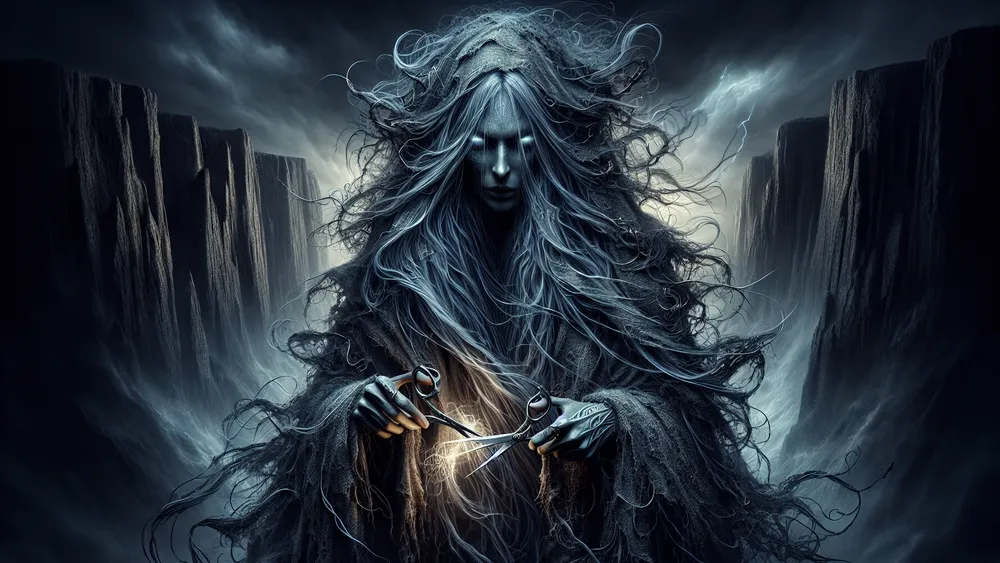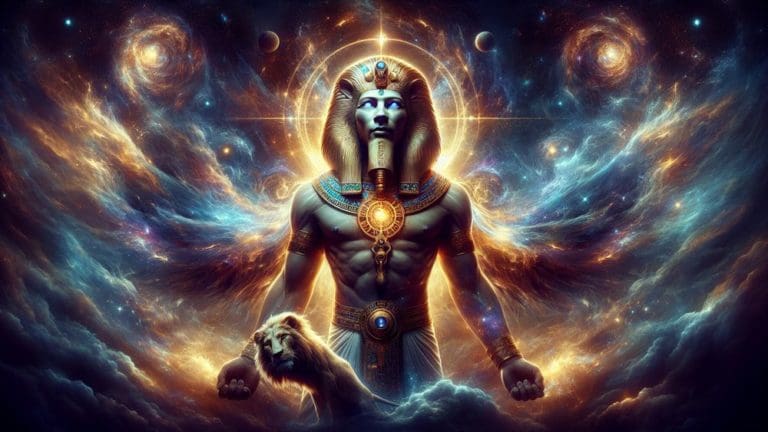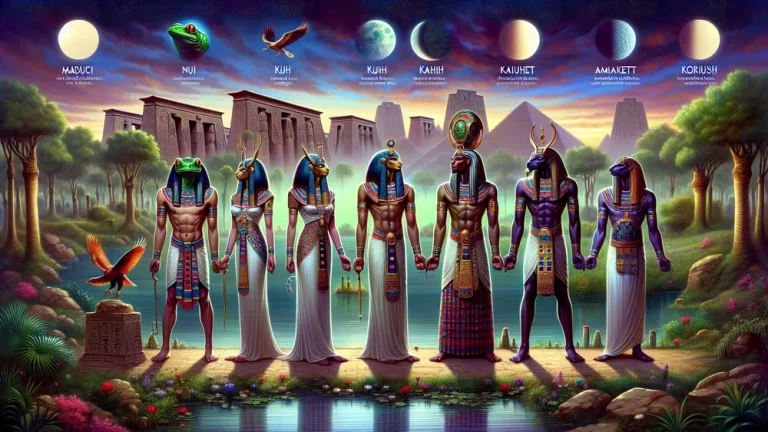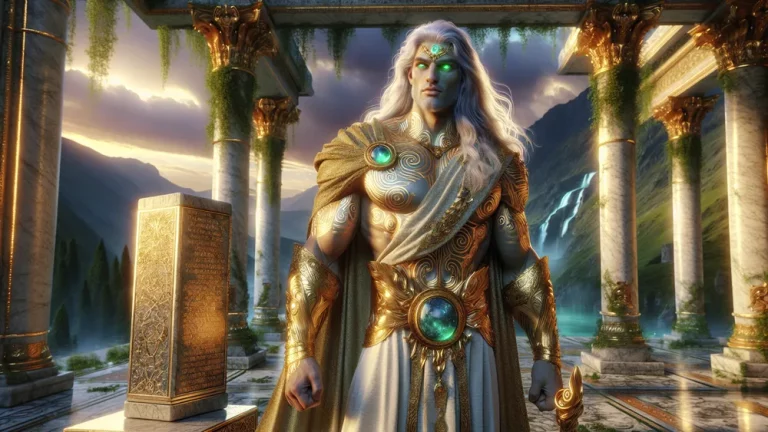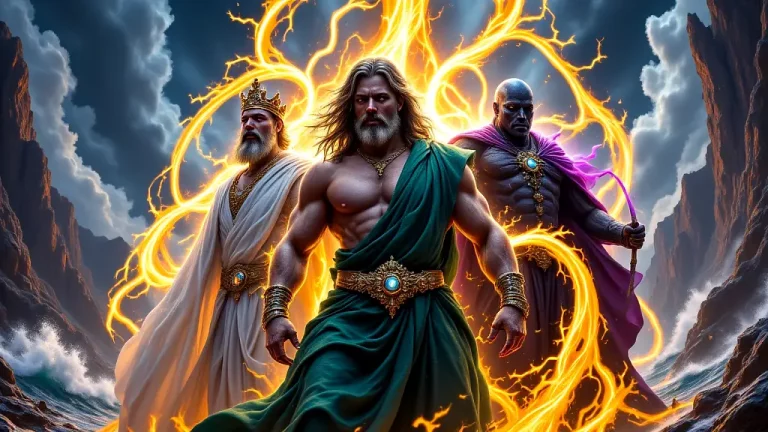Atropos: The Unyielding Fate Who Cuts The Thread Of Life
In Greek mythology, Atropos comes forward as a person of great importance. She is part of the Moirai, or Fates, who have control over the course of existence (both for people and gods). Life was viewed by the ancient Greeks as being like a thin thread. This thread – they thought – was something these three sisters handled. First, Clotho made it by spinning.
Key Points:
- Atropos is one of the three Fates and cuts the thread of life, representing the end of life and the idea of unavoidable death.
- Greeks believed life followed a set path, which Clotho spun, LachESIS measured, and Atropos ended.
- Her power applies to everyone, even gods like Zeus, showing a system where no one escapes fate.
- The thread of life concept illustrates birth, living, and dying as a connected and delicate line.
- Symbols like scissors or shears mean her role as life’s finisher when the right time comes.
- Stories like King Admetus and Meleager display Atropos ensuring fate happens as planned, despite efforts to change it.
- Greeks honored the Fates in rituals and saw Atropos as a practical way to understand and accept death as part of life.
LachESIS decided how far it stretched. And Atropos? Atropos would finish everything by cutting it. Ever think about how the Greeks made sense of life being uncertain, while still knowing death was always coming? That’s what the Moirai were about. It’s what Atropos meant, too. Life seemed like a story. From the start to the end, they had control – every stage of it.
Clotho began beginnings, LachESIS worked on what happened in the middle, and Atropos cut it into an ending. This wasn’t about chance or surprise, though. This trio stood for the idea of rules – rules nobody could get out of. Not even gods. The way they thought about it back then, it was something amazing but also pretty serious at the same time.
This post looks at the myths, stories, and cultural beliefs tied to Atropos. By doing so, we can try to understand how the Greeks saw both life and death – and people’s place in between those two things.
Atropos: Overview and Key Facts
| Aspect | Details |
|---|---|
| Name | Atropos (Ἄτροπος in Greek). The name means “the unturning” or “the one who cannot be avoided.” |
| Role | One of the three Moirai (Fates) in Greek myths. Her job is to cut the thread of life, which marks when a person dies. |
| Siblings | Clotho (who spins the thread to start life) and LachESIS (who decides how long it will last and what happens during it). |
| Symbolism | Stands for the end of life, how death cannot be avoided, and how fate cannot be changed. |
| Iconography | She is usually seen holding scissors, shears, or a blade. These objects show her job of cutting the thread of life. |
| Domain | Atropos controls both death and fate. She makes sure the lives of all beings – mortals and gods alike – end when they should. |
| Powers | Her power is total. In Greek stories, even Zeus, the leader of the gods, cannot stop her decisions. She has the highest authority over how life ends and the future of everyone. |
| Cultural Interpretation | With her sisters, Atropos expressed the Greek idea that life follows a set course. Death is part of this pattern, and it cannot be escaped. |
| Associated Mythology | Atropos appears in myths that focus on how destiny always happens, like those of King Admetus, Meleager, or heroic deaths in Homer’s “Iliad.” |
| Other Attributes | Called “The Irrevocable.” Her role is to make sure that no mortal, god, or creature can avoid their ending. |
| Significance Today | Atropos is still seen as a symbol for death and how it’s an unchangeable part of life. People remain fascinated by life and its connection to fate today. |
What Atropos Means to Greek Mythology
Atropos is a key part of Greek myths. She stands for the certainty of death. This was an idea that couldn’t be ignored, and nobody could escape it. If we want to understand why she matters, there are a few things we need to think about. Her role, who she is, how she works with her sisters – all of that helps explain her place in these stories.
And her power? It reaches into every part of life and beyond, touching both mortals and even the gods.
Who Is Atropos in Greek Myths?
Atropos, whose name means “the unturning” or “unavoidable,” is part of the trio called the Moirai – the Fates in Greek mythology. She has the serious and important job of deciding when every mortal life comes to an end. With her shears, she cuts the thread of life, marking death. Life to the Greeks was like a thin thread, fragile and stretched between the hands of the Fates.
Clotho spun it, LachESIS chose how long it would be, and Atropos would use her tools to cut it when the right time arrived. Her name, “unavoidable,” points to her unshakable power. No one – neither humans nor gods – could stop her from carrying out her job. What sets her apart from her sisters is that she doesn’t create or shape a life’s course. Instead, her role is simple: to end it.
She is a reminder of death itself in Greek mythology, representing the truth that all life must eventually come to a close.
- Key Descriptors for Atropos:
- Unyielding: She never changes her mind about what destiny requires.
- Final: Atropos makes sure that the thread of life always gets cut.
- Irrevocable: Nothing can undo her decisions, not even the might of Zeus.
Atropos, the unchanging Fate in Greek mythology, has the sole and final role of cutting the thread of life, ensuring every life eventually ends, a decision no one can undo.
How the Three Fates Work Together
The Moirai, thought of as three goddesses tied closely to the ideas of time and fate, work together as the ones who decide every human life in Greek myths. Each one has her own unique job, but none of them could do their work alone – everything they do depends on the others.
Clotho, often called “the spinner”, begins life by making the thread of existence. This thread is like a new path being started. Then there is LachESIS, whose name means “the allotter.” She decides how long the thread will be, giving each person their course in life, including how long they live and what might happen during their life.
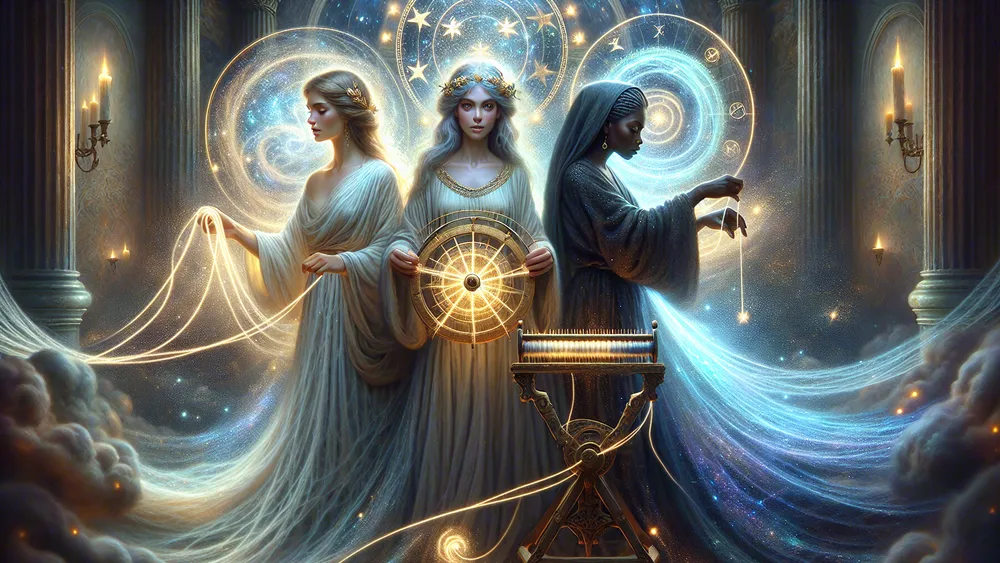
Finally, there is Atropos. Her name means “the one who cannot be avoided.” Atropos ends the thread with a cut, making the final decision when a life is over. Think of the Fates as workers on a massive project. Clotho starts by spinning the thread. LachESIS works on the details, figuring out how long to make it.
And then Atropos steps in to finish the work and cut it at just the right time. Their teamwork explains how the Greeks saw life: everything beginning, living, and finally ending in an orderly way. Everything is connected – the start, the middle, and the end.
- The Roles of the Three Fates:
- Clotho: Spins the thread of life. She represents birth and beginnings.
- LachESIS: Decides how long the thread is, standing for destiny and life’s events.
- Atropos: Cuts the thread, meaning death and the end of life.
Atropos’s Power Over Everyone – Gods Included
Atropos’s power in Greek mythology goes far beyond the role of a simple judge of death. Her influence is an unchanging force that even the Olympian gods cannot fight. The ancient texts describe the Fates – Atropos being one of them – as working without interference from Zeus or the other gods. This means their power doesn’t come from Olympus but instead from an older, more ancient system of rules.
For example, Hesiod’s Theogony says the Fates were the daughters of Nyx (Night), a figure tied to the basic parts of the universe. But some stories describe them as children of Zeus and Themis, the goddess of justice. Regardless of their origins, one thing is always clear: Atropos follows rules that no being can escape or undo.
Even Zeus himself, considered the most powerful of all gods, is said to respect the decisions of the Fates without trying to stop them. This shows a rare case where the gods must obey a higher force. It helps to imagine a system where the gods can shape human lives through their actions, but they too are limited by fate. Atropos represents this higher rule.
Her role is to cut the thread of life, whether it belongs to a goddess or a human. This is done with complete fairness – heroics, sacrifices, or divine status have no effect. Take the Trojan War, for example. Warriors like Achilles and Hector, despite their strength and godly favor, were not able to escape death once the Fates had decided it.
Their deaths remind us that no thread, no matter how bright or strong, can avoid being cut. This power made Atropos both respected and feared in Greek culture. She was a symbol of death’s certainty, holding power over all beings – mortal and immortal alike.
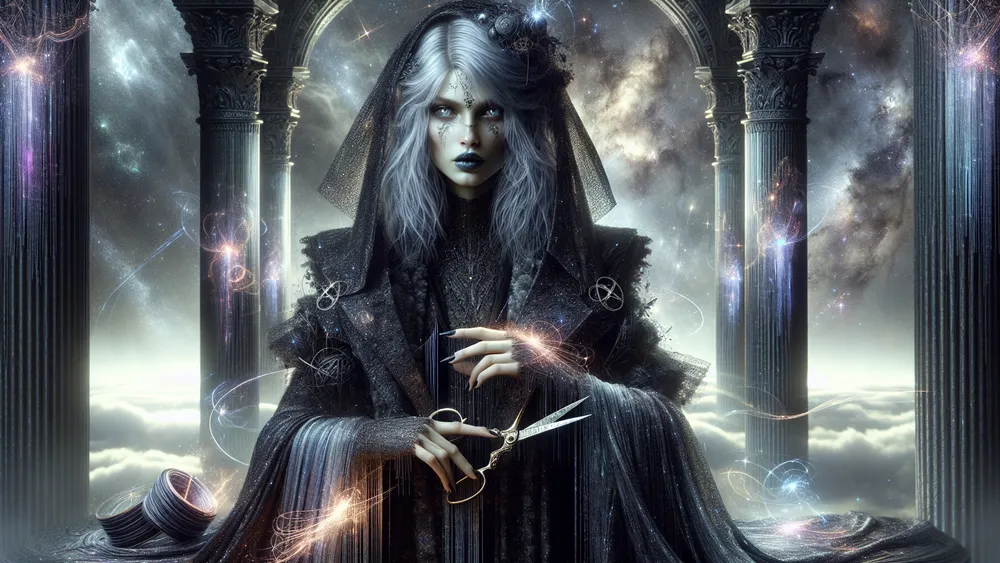
Atropos and the Thread of Life
What Atropos is best known for is the thread of life. This thread is an essential way to think about how life works for each person. It stands for human existence from start to finish. To understand her role more clearly, we can look at this thread and what it tells us about life and the work of Atropos.
It’s something that explains a lot – like birth, how life moves forward, and when it ends.
How The Thread of Life Describes a Life’s Journey
In Greek mythology, the thread of life is used to explain a person’s path, from the start of their life to their end. This thread is made and controlled by the three Moirai, who each do a job that matches a different part of life. First, Clotho, who is called the spinner, starts the thread. This stands for the creation of life and the possibilities that come with being born.
Then, LachESIS, or the measurer, takes the thread and decides how long it will be. What she does means setting the events, choices, and situations that will determine how a person’s life happens. Last of all, Atropos, the cutter, finishes the thread. She is the one who ends the person’s life by cutting it at the time that has been decided.
The thread works much like a timeline. It stretches from birth to death: while Clotho spins the start and LachESIS measures the rest, Atropos makes sure it is cut at the final point. This thread, which stands for how life is connected and delicate, shows something else. No thread can be changed after it is spun, measured, or cut.
Each thread is unique, with its own length and texture, but they are all part of something bigger. For example, the story of Meleager explains this idea. His life was tied to a burning log, and when the log burned out, Atropos cut his thread, ending his life. Not even gods could stop this from happening.
The thread isn’t just a way to think about life – it’s a real example of how ancient Greeks believed destiny worked.
| Stage of Life | Fate Responsible | What It Means |
|---|---|---|
| Birth | Clotho | Starts life by spinning the thread. |
| Life | LachESIS | Decides the thread’s length and life events. |
| Death | Atropos | Cuts the thread, ending a person’s life. |
The Symbols That Represent Atropos
Atropos is best known for the tools that stand for her role in ending life. The scissors or shears are the most famous. These tools are what she uses to cut the thread of life, which Clotho spins and LachESIS measures. In some versions of the myths, instead of scissors, she is shown using a knife or blade to do the cutting. These instruments are not chosen by accident.
They explain her responsibility in making sure every life is finished when its time comes to an end. To make the idea clearer, think of scissors as tools that cut a piece of cloth, bringing it to completion. Using them is not just about destruction – it is also necessary for finishing the job. The thread of life, which people usually connect with Clotho, also explains what Atropos is in charge of.
She is the one who gives the thread its purpose by cutting it. Together, these symbols make it easier to understand how Atropos is tied to the certainty of death and the end of life’s path.
- Key Symbols of Atropos:
- Scissors or shears: Represent her cutting the thread of life, ending it.
- Knife or other cutting tools: Different ways the myths describe the tools she uses.
- Thread of life: Represents human life and its end through her final act.
Famous Stories About Atropos
Atropos’s great control over life and death is something we often see in ancient myths. Her power is clear in many stories, which talk about how she plays her part as one of the Fates. There are several stories where she is important. One main example is how she cannot be avoided when it is time for a life to end.
The Story of King Admetus and Alcestis
The story of King Admetus and his wife Alcestis is one of the most touching and important tales in Greek mythology. It explains how the Moirai, and especially Atropos, carried out fate without compromise. Admetus, who ruled over Pherae, was highly favored by the god Apollo, who stayed with him for a year as punishment for killing the Cyclopes.
While Apollo lived in his court, he worked with the Moirai to make Admetus’s life longer. A deal had to be made for this to happen: Admetus’s death could be delayed, but only if someone else was willing to take his place in the underworld. It was Atropos’s job to cut the thread of the person who would die.
This thread, cut by her scissors or another sharp tool, symbolized the end of life. Even though Apollo helped, the Moirai held firmly to the rules of fate – death could be postponed, but never entirely avoided. Someone had to die. When the time came, Admetus’s friends and family turned away. They refused to take his place, leaving him alone to face the consequences. However, his wife, Alcestis, did something remarkable.
She gave her life for her husband. Atropos agreed to this and cut Alcestis’s thread, following the terms of the deal, but still making sure fate’s rules were respected. Later, Heracles stepped in. He fought with Thanatos (Death) and brought Alcestis back to life. Yet, this act did not change Atropos’s role as the one who controls death.
Her job was to make sure life ended when it was time, no matter what happened afterward. This story shows that even gods could delay fate – but they could never stop Atropos from doing what had been decided.
Alcestis sacrificed her life to save her husband Admetus, but fate’s rules, controlled by Atropos, allowed no escape from death, only delay.
The Tale of Meleager’s Death
The story of Meleager is an example of how the Moirai tied someone’s entire future to a simple object. When he was born, they came to his mother, Althaea, and said his life would only last as long as a certain log burned in the hearth.
Clotho spun the thread of his life, LachESIS decided how long it would be, and Atropos, silently, promised to cut it when the log stopped burning. Wanting to stop this, Althaea quickly grabbed the log from the flames and put it somewhere safe, thinking she could protect her son’s future.
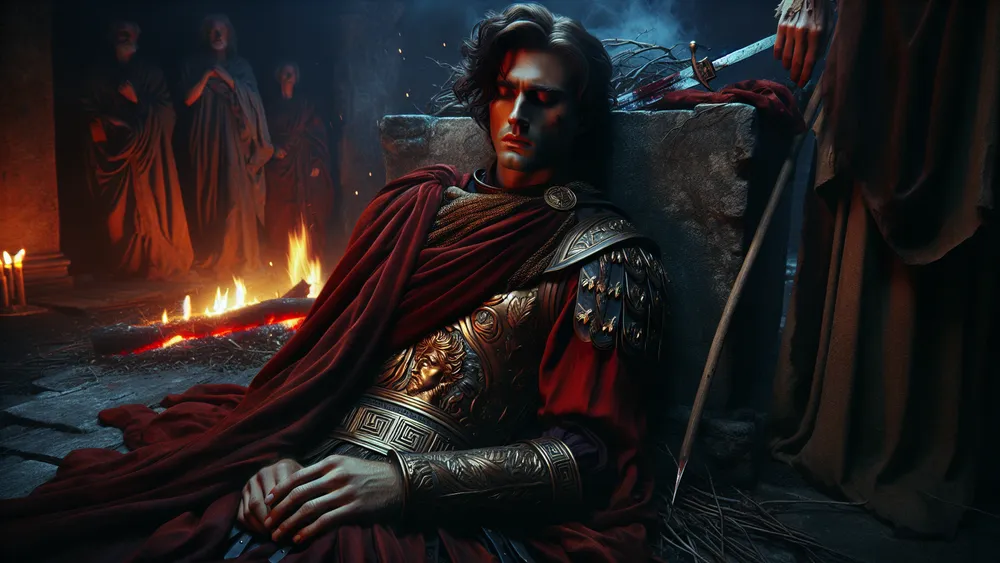
But by tying Meleager’s life to the log, the Fates made his existence fragile – and eventually, the prophecy could not be avoided. Years later, after the famous Calydonian Boar Hunt, Meleager became furious during a fight over dividing the spoils. Angered by his uncles, who were Althaea’s brothers, he killed them in his rage. When Althaea heard this, grief and anger overwhelmed her.
She took the hidden log and threw it into a fire. As the log burned, the thread of Meleager’s life was cut by Atropos, fulfilling her role, and he died. This story makes clear how Atropos’s duty is connected to the certainty of death – something no one, not even a desperate mother, could stop. The burning log, fragile and easily destroyed, shows how the ancient Greeks connected life and death to real, physical objects.
Atropos’s Role in Homer’s Iliad
In Homer’s Iliad, death is something that all the heroes must face, reminding us of Atropos’s unavoidable role in how both life and fate work. Even though she is not named directly in the poem, her presence is clear. The story makes it obvious that fate is stronger than all – stronger than even Achilles or Hector.
On both sides of the Trojan War, every hero is connected to threads of life, and the moment their lives will end is already decided by the Moirai. When Hector faces Achilles, his fate cannot be changed. It doesn’t matter how brave Hector is or what strategies he uses; the end was already written. The same thing happens to Patroclus, who dies even though he is wearing Achilles’s armor.
His life could not be saved because fate had already made the choice for him. It is Atropos, the one who cuts the threads of life, who makes sure these endings happen. Homer describes these deaths in detail and talks about how the gods sometimes feel sad because they cannot change what has already been decided.
They cannot save the heroes, even if they want to. These moments make the power of the Moirai clear, and how Atropos is the one to finish what has been decided. This idea of fate runs through the entire Iliad. No matter how great or heroic someone is, their destiny cannot be avoided.
Atropos’s Influence on How Greeks Saw Life and Death
Atropos had a major role in deciding what happened in the end, and this was an important part of how the ancient Greeks thought about life and death. What she did, as the one who carried out fate’s decisions, changed how Greeks saw these things.
We can look at how her influence spread through their rituals, their beliefs, and their different ways of thinking about the world. This was not just about ideas, but also about practices and traditions that shaped their outlook on everything from living to dying.
Ancient Greek Rituals Honoring the Fates
The Moirai were highly respected in ancient Greece. To honor them, people performed rituals and gave offerings to stay connected to the destiny the Moirai controlled. In these ceremonies, they gave food – things like honey, cakes, and bowls of milk – at shrines or altars made for the Fates. Some ancient writings tell us these offerings meant people hoped to satisfy the Moirai.
They wanted to make sure their destinies would be good, or at least to avoid something bad from happening. Although we don’t see much evidence of people celebrating only Atropos, it seems that prayers and sacrifices were made to all three sisters together. Another important moment in these rituals was whenever a child was born.
People would call the Moirai to help the baby live a long and happy life. This practice of leaving offerings or asking for good fortune was meant to gain favor with higher powers. Similar things are seen today – like lighting candles or making a wish – but for the Greeks, these rituals were part of something much bigger.
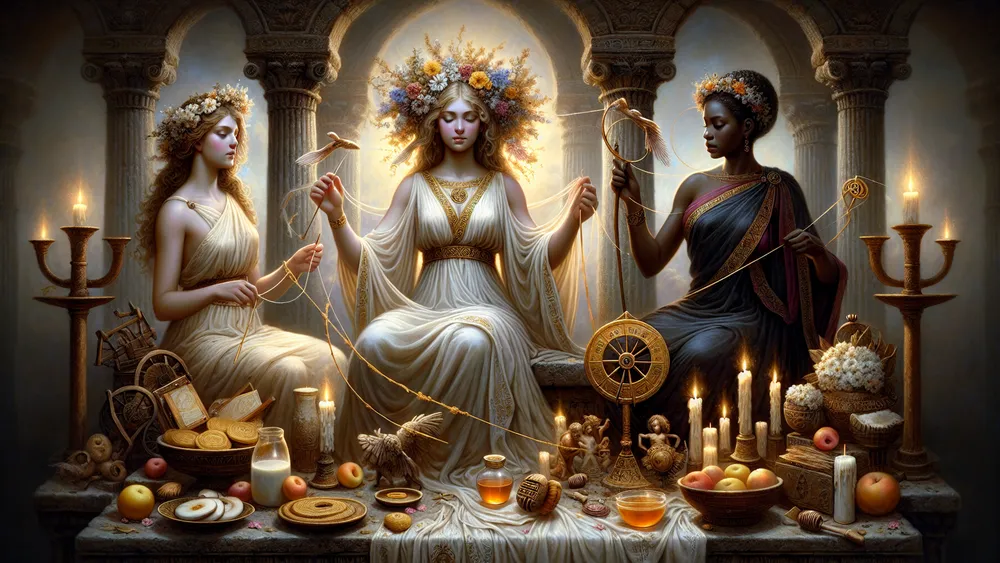
They wanted to live with fate on their side and stay in harmony with the way things were meant to be.
How Atropos Helped the Greeks Understand Death
Atropos was the one in charge of cutting the thread of life, which helped the ancient Greeks think about death as something they couldn’t avoid. Her job, which had to do with deciding when life would end, made it clear that no matter how long or complicated a life might be, all lives came to an end. This wasn’t random.
Instead, it followed a plan that was already decided, something even the gods had to follow. Because the Greeks saw death as part of a larger order of the universe, they thought about it as an event that wasn’t chaotic or unfair. Rather than seeing this as cruel, the Greeks personified death as Atropos – a strict and impartial figure who made decisions about life’s end.
Through this act, they were able to face death in a way that accepted it instead of being afraid of it for no reason. Think of life as a thread, part of something large, like a fabric. When that thread was finished, Atropos was the one who cut it at the proper time.
In myths and Greek religion, Atropos’s actions supported the view that death wasn’t chaotic but followed a cosmic order. Even philosophers like Plato thought that death was not the final stop, but rather a step toward something else, decided long before it happened. When people honored the Moirai, especially during funerals, they would pray for the soul to leave peacefully.
This reflected the belief that Atropos was just fulfilling a necessary job in the life cycle. When life ended too soon or something unexpected happened, the Greeks turned to Atropos as the one responsible, so they could make sense of it. They didn’t blame random events or people. Instead, they believed fate controlled everything.
This let them view loss as part of the natural structure of things – something planned and connected to the universe itself. Through her work, Atropos let the Greeks see death as part of life, tied together by a system that had meaning and purpose.
Pantheon of All Greek Mythology Abstract and Natural Forces
The ancient Greeks created a system of gods to represent both ideas and forces in the world. Through these figures, they explained everything from human life to nature itself. Whether it was justice (Dike), strength (Kratos), or even the unavoidable end of life represented by Atropos, they gave divine meaning to everything.
Each part of life, no matter how small or large, had some connection to a god who stood for it. The Greeks believed that these gods formed part of a bigger system. They saw a world where ideas and events, even those they couldn’t fully understand, were tied to something divine.
For a deeper look into how they explained all these forces of nature, you can visit this list of Greek Abstract and Natural Forces. This way of thinking helped the Greeks make sense of both everyday life and deeper, less obvious things like ideas or invisible forces. The gods weren’t just symbols – they were essential to how the Greeks thought about the world around them and how everything connected.
FAQs
1. What are the key distinctions between Clotho, LachESIS, and Atropos?
The key distinctions between Clotho, LachESIS, and Atropos lie in their roles: Clotho spins the thread of life, LachESIS measures its length, and Atropos cuts it to signify death.
2. What is the symbolism behind Atropos’s scissors?
The symbolism behind Atropos’s scissors lies in their representation of the irrevocable finality of death, as they sever the thread of life at its destined endpoint.
3. How does Atropos compare to Roman or Norse representations of fate?
Atropos compares to Roman or Norse representations of fate by serving a similar role to the Roman Parcae’s Morta and the Norse Norns, particularly Skuld, as an enforcer of inevitable death and destiny.
4. Is Atropos always portrayed negatively in mythology?
Atropos is not always portrayed negatively in mythology, as her role emphasizes the natural and inevitable cycle of life rather than malevolence.

